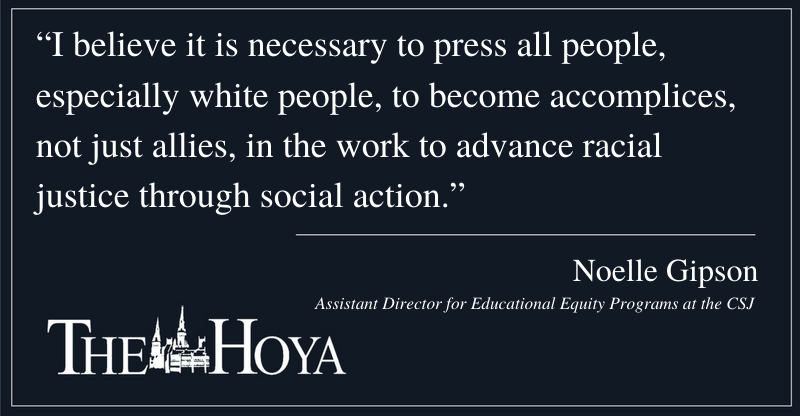Every February, I get mixed emotions about Black History Month. I’m not conflicted about the value of recognizing and reflecting on African American history. However, I am concerned that there are still not enough non-Black people who engage in racial justice work daily given the history of racism African Americans have endured for decades. For example, it wasn’t until 2009 that the first African American was elected president of the United States.
I believe it is necessary to press all people, especially white people, to become accomplices, not just allies, in the work to advance racial justice through social action. Too often, I encounter allies of racial justice who only want to read, talk and think about racial justice work. We need more people to become accomplices who are willing to engage in the struggle for justice by taking action against racism. For example, an ally would simply hang a picture of Dr. Martin Luther King Jr. on their office wall or read a poem by Maya Angelou to a classroom of students. On the other hand, an accomplice would ask questions about the low numbers of Black administration, faculty, staff and students who are given the opportunity to work and learn in institutions of higher education. Furthermore, an accomplice would actively interview and hire African Americans as a way to rectify the history of marginalization and racism in American workplaces.
As I reflect on African American history in the United States and the existence of white accomplices, I think about the courageous white people who actively engaged in antiracist protests and the struggle for racial justice. Even more inspiring is that there were Black and white recent college graduates who worked together to advance justice and freedom for African Americans.
In 1961, Carol Ruth Silver was one of the first two white women arrested in the Freedom Rides. Silver was a recent graduate of The University of Chicago and chose to serve as a Freedom Rider because she believed racial segregation was an injustice. Genevieve Hughes Houghton, a white woman, is another example of an accomplice who was willing to speak out against racism and risk her life to advance justice for Black people in the United States. Houghton grew up in Chevy Chase, Md., and decided to play an active role in the fight for racial equality and integration by serving as a Freedom Rider.
I also want to highlight that in the 1960s, there were brave white men who engaged in the fight for racial justice. James Peck, a white man, was born into a wealthy family and began college at Harvard University before he joined the Freedom Riders. In 1961, Peck was beaten by the Ku Klux Klan for his participation in the Birmingham Freedom Ride. Peck was willing to serve as an accomplice in the struggle for racial integration. He is an example of a white man who is an accomplice because he engaged in social action that challenged white supremacy and white privilege.
James Zwerg was another white man who joined the civil rights movement in the 1960s. James recognized the racism his Black roommate encountered when his roommate was not allowed in his all-white fraternity house. Zwerg participated in an exchange program in which he spent a semester at Fisk University, a Historically Black University, and learned about social action movements to integrate restaurants and public transportation. Zwerg boarded a bus with Black young adults, including John Lewis, who traveled from Birmingham, Ala., to Montgomery, Ala., as a way to protest the segregation.
Silver, Houghton, Peck and Zwerg are all accomplices who have a significant role in African American history alongside leaders including Diane Nash, Lewis and Hank Thomas because they were all willing to risk their lives to dismantle white supremacy, give up their privileges and protest for civil rights. Georgetown students of all racial groups should become accomplices by supporting Black businesses, speaking to faculty and administration about the need to continuously hire Black faculty, staff and administration, and challenging racist comments and acts that show up on college campuses and in the community. I challenge every reader to not only celebrate Black History Month during the month of February but to also become an antiracist and accomplice 365 days every year.
Noelle Gipson is the assistant director for educational equity programs in the Center for Social Justice Teaching, Research and Service at Georgetown University.















Carol Ruth Silver • Mar 1, 2020 at 1:58 am
Honored and humbled, I want to thank Noelle Gipson, for having singled out myself and other participants in the 1961 Freedom Rides for special recognition as “accomplices” to the brave African-Americans who led the fight against Jim Crow discrimination. In celebrating this Black History Month, we remember also the martyrs whose lives were cut short in this fight, Emmett Till and Martin Luther King, Jr., and John Brown, and all the unrecorded victims of lynchings throughout the South. And to all those who want to do something to advance the cause of equality, of justice for all, please remember, as the 16 year old climate warrior Greta Thunberg has said, “No one is too small to make a difference.” Carol Ruth Silver 2020 February 29th